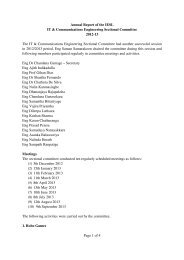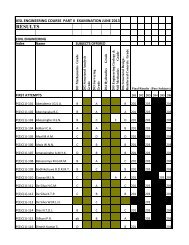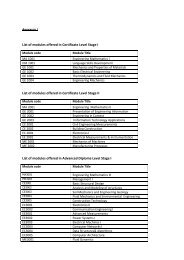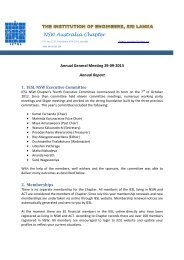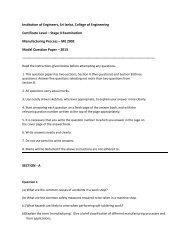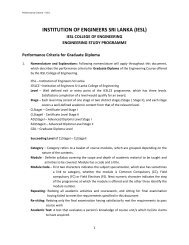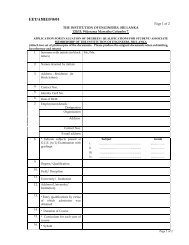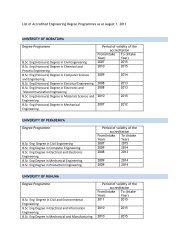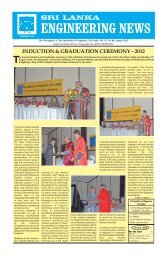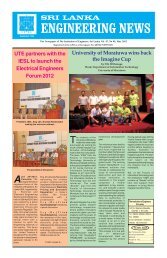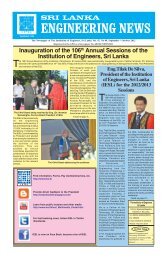Download - IESL
Download - IESL
Download - IESL
You also want an ePaper? Increase the reach of your titles
YUMPU automatically turns print PDFs into web optimized ePapers that Google loves.
Sri Lanka Engineering News - January 2012<br />
“The following article was written by Eng A.M. Amila Shivanthaka Dayarathna,<br />
attached to the National Water Supply and Drainage Board, a Postgraduate student<br />
following an MSc course in Environmental Engineering at University of Moratuwa<br />
as an assignment given at the start of the program and was forwarded to SLEN by<br />
Eng. Prof Mrs. Niranjanie Ratnayake, Senior Professor, Department of Civil<br />
Engineering, University of Moratuwa”<br />
My Efforts to Implement Sustainable<br />
Development Principles at Site<br />
As humans, we<br />
consume resources<br />
in various forms to<br />
perform our day to day<br />
activities and to preserve our<br />
comfort. From the alarm we<br />
wake up in the morning to<br />
the light we turn off to sleep,<br />
it is resources that we<br />
consume. It is not just you<br />
and me, but the massive<br />
seven billion of people all<br />
around the world use their<br />
portion of resources, daily.<br />
However, the earth being an<br />
isolated globe in the<br />
universe, has a very limited<br />
amount of resources<br />
available to be consumed.<br />
There we have the<br />
importance of consuming<br />
these resources to meet our<br />
needs while preserving<br />
them for the future<br />
generations, which is called<br />
“Sustainable Development”<br />
in short. While we must all<br />
do our part to minimize our<br />
ecological foot print by<br />
taking measures for<br />
resource conservation in our<br />
activities as individuals, we<br />
engineers have a bigger role<br />
to play, as our profession<br />
inherently makes use of<br />
large amounts of resources,<br />
as given in the definition of<br />
Engineering - “the Art and<br />
the Science of working with<br />
the great sources of power<br />
in nature for the use and<br />
benefit of Society”<br />
Being a Civil Engineer<br />
employed as a construction<br />
consultant of a 1500m3 capacity, 32m high water<br />
tower, I have the<br />
responsibility to carry out all<br />
my activities ensuring<br />
Sustainable Development.<br />
As a construction<br />
consultant, a major<br />
responsibility assigned to<br />
myself is carrying out site<br />
inspections especially prior<br />
to concreting. An Elevated<br />
reservoir being a water<br />
retaining structure, carries a<br />
high risk of deterioration due<br />
to corrosion of steel<br />
reinforcement. If corrosion<br />
takes place within the<br />
structure, lifespan of the<br />
structure will shorten<br />
dramatically. Shorter<br />
lifespan will lead to frequent<br />
repairs or reconstructions<br />
consuming a lot of materials<br />
and labour. So, verifying a<br />
long lasting construction<br />
during my inspections will<br />
ensure saving of resources<br />
in the future. Considering<br />
this fact, I pay my fullest<br />
attention to crucial facts like<br />
maintaining clear cover to<br />
ensure durable<br />
construction. I have noticed<br />
and corrected small binding<br />
wires extruding towards the<br />
surface of the concrete from<br />
the main reinforcement.<br />
These small extrusions will<br />
be corroded and will be<br />
carrying moisture to main<br />
reinforcement if ignored.<br />
So, as a construction<br />
consultant, I pay my<br />
attention even on a small<br />
binding wire to ensure the<br />
durability of the structure to<br />
make sure I play my role in<br />
Sustainable Development.<br />
A common way of energy<br />
and materials being wasted<br />
on construction sites is<br />
double work. If a concrete<br />
is not vibrated properly<br />
while pouring, it might<br />
result in honeycombs<br />
which needs to be attended<br />
later. The same thing can<br />
be resulted in cases of<br />
cement grout being leaked<br />
through formwork joints.<br />
Even a small thing like<br />
placement and<br />
arrangement of falsework<br />
will consume a lot of time<br />
and energy if it has to be<br />
re-arranged at the next level<br />
concrete. So, I assist the<br />
contractor providing<br />
suggestions and<br />
instructions to avoid such<br />
double works to save time,<br />
energy and materials.<br />
Another way that the<br />
resources being wasted on<br />
construction sites is lack of<br />
planning on activities. In this<br />
particular water tower, it<br />
includes a lot of complex<br />
reinforcements to be<br />
performed. And in some<br />
places, it is necessary to<br />
consult the structural<br />
engineer and seek for<br />
alternative reinforcement<br />
arrangements to ensure<br />
the flow of concrete through<br />
reinforcement. I even do 3D<br />
drawings of reinforcement<br />
to ensure the detailing is<br />
correct, before approving<br />
the bar schedules for bar<br />
bending. If it was not<br />
corrected there, the bended<br />
bars will have to be cut and<br />
new bars will have to be<br />
placed in case of any<br />
change to the<br />
reinforcement after binding<br />
the bars. The same way,<br />
concrete pouring schedules<br />
are checked prior to<br />
concreting, considering<br />
road traffic, batching times,<br />
pouring times…etc, to<br />
avoid any delays or<br />
wastages of concrete. This<br />
way, I can ensure the site<br />
activities are being carried<br />
out with proper planning<br />
which in turn lead to<br />
sustainable development.<br />
Effective outcome of the<br />
labourers is a critical<br />
achievement in terms of<br />
activity durations and the<br />
quality of work. This is<br />
achieved by preparing them<br />
a safe and hygiene working<br />
environment by frequent<br />
Safety Audits. A full<br />
inspection of the site is<br />
carried out during a Safety<br />
Audit including toilets,<br />
garbage pits, hidden corners<br />
of buildings and roof tops.<br />
Attention is paid on possible<br />
mosquito breeding sites, non<br />
hygienic environments in<br />
wash rooms, changing<br />
rooms and toilets during the<br />
audit. Also the safety<br />
concerns are addressed<br />
during the audit. All the<br />
labourers shall wear safety<br />
boots, gloves, safety<br />
harnesses (where<br />
necessary), helmets for their<br />
own safety. All paths where<br />
people travel in the site shall<br />
be clear and well defined.<br />
Labourers working at high<br />
elevations shall be provided<br />
with proper working<br />
platforms…etc. All these will<br />
lead to an effective outcome<br />
from the labourers and it will<br />
contribute to sustainable<br />
development by minimizing<br />
construction times and<br />
wastages.<br />
While construction is to be<br />
blamed as the major reason<br />
for deforestation, we have<br />
managed to maintain an<br />
environmentally friendly site<br />
as much as we can. We<br />
have retained the trees which<br />
were originally there at the<br />
site as much as we can and<br />
have cut only that is must.<br />
We have planted new trees<br />
celebrating world<br />
environment day which<br />
keeps the worksite and the<br />
environment in harmony.<br />
Apart from all of the above<br />
concerns, I can still practice<br />
sustainable development in<br />
the office environment by<br />
printing what is must,<br />
adjusting the A/C<br />
temperature at 25~26C0 range, turning off<br />
unnecessary lights, turning off<br />
computers if not used…etc.<br />
From all of the above, it feels<br />
like I am contributing towards<br />
Sustainable Development to<br />
a certain extent. If all seven<br />
billion of us can think and act<br />
towards using our resources<br />
effectively, and saving them<br />
for the next generation, this<br />
world will be full of beautiful<br />
faces, even tomorrow.<br />
Contd. from page 1...<br />
Highway .....<br />
decreases as you slow down.<br />
Both have the effect of the<br />
intruder exiting the cocoon.<br />
Rear end management: A rear<br />
end intruder in to the cocoon is<br />
more difficult to handle. One<br />
thing you can do is to speed up<br />
to leave the intruder behind or to<br />
slow down so that the cocoon<br />
shrinks having the same effect.<br />
This gives a chance to the<br />
intruder to slow down unless he<br />
is on a suicide mission.<br />
In Bahrain, where I live, such<br />
suicide missions are quite<br />
common and both methods<br />
mentioned above may not be<br />
practicable when you find a<br />
Dodge Charger or a Chevrolet<br />
Camaro suddenly appearing<br />
behind your car as if<br />
materializing out of thin air. The<br />
guy will not stop at the<br />
miraculous act of making a<br />
sudden appearance but will also<br />
maneuver in to kissing distance<br />
from your rear bumper. You have<br />
to remember that all this drama<br />
is taking place at a speed of<br />
above 100 km/hr. Whatever<br />
other short comings these<br />
bumper kissing Formula 1<br />
drivers have, sounding the horn<br />
in irritation as in SL is not one of<br />
them. No Sir, they are very polite<br />
that way.<br />
Shrinking the cocoon is not a<br />
solution in this case because<br />
the guy is just a few millimeters<br />
behind you anyway and if your<br />
cocoon shrinks any more its<br />
boundary will enter your vehicle,<br />
which of course is no man’s land<br />
for cocoon boundaries.<br />
How about the other option of<br />
speeding up? Did you say<br />
speeding up? Speeding up with<br />
a supercharged 3000 cc<br />
monster firing 8 cylinders<br />
against your measly 1200 cc 4<br />
cylinders? You have to be crazy<br />
to try that option. Even if you<br />
succeed, the guy behind will<br />
take it as a challenge and start a<br />
racing competition with you,<br />
which is not going to be very<br />
pleasant, I can assure you,<br />
though it may be thrilling to the<br />
other spectators. Thus,<br />
changing to the other lane is the<br />
only option left unless it is<br />
already occupied by a driver on<br />
another suicide mission.<br />
Changing Lanes: Bahrain is full<br />
of skilful drivers some of who are<br />
experts at lane hopping. While<br />
the rest of the traffic moves at a<br />
legal limit of 100 km/hr these<br />
lane hoppers weave left and<br />
right and fly through seemingly<br />
impossible gaps at something<br />
like 150 km/hr resembling<br />
swallows feeding on a swarm<br />
of flies.<br />
Lane changing without proper<br />
preparation and letting your<br />
intention known to other drivers<br />
around you is extremely<br />
dangerous. You have to use your<br />
rear view mirror and the side<br />
mirrors to ensure that it is safe.<br />
You have to be mindful about the<br />
blind zone in the side mirrors.<br />
The side mirrors do not show<br />
any vehicles in this zone. This<br />
can be overcome by attaching<br />
two small higher curvature<br />
convex mirrors on the side<br />
mirrors or a quick glance over<br />
your shoulder.<br />
The turn indicator lamps must<br />
be turned on before you execute<br />
<strong>IESL</strong> NEWS<br />
the maneuver. In countries like<br />
the US it is a serious offence if<br />
you change lanes without<br />
switching on the turn indicators<br />
even if the other lane is empty.<br />
The lane weavers in Bahrain do<br />
not need the side mirrors or the<br />
lights and any way do not use<br />
them because the rear view<br />
flashes by - in fact the whole<br />
future flashes by at high speed<br />
for them - in something like<br />
Einstein’s time dilation effect.<br />
But lesser mortals like us<br />
cannot depend on Einstein for<br />
these things.<br />
Once upon a time in Bahrain,<br />
an electrical engineering<br />
undergraduate did a research<br />
on the life of various kinds of<br />
lamps and found that turn<br />
indicator lamps are the longest<br />
lasting. The reason was found<br />
to be that they are hardly ever<br />
used. In fact they are used only<br />
when one learns driving after<br />
which they serve only some sort<br />
of decorative purpose. Any driver<br />
who uses turn indicators is<br />
considered as a novice and<br />
other drivers give him or her<br />
looks of disdain or pity as they<br />
pass him/her. It is almost like<br />
having a big L board on your car.<br />
But there is a time when even<br />
the experienced drivers turn<br />
them on. That is during foggy<br />
conditions. At these times, they<br />
become over enthusiastic and<br />
as if in an effort to catch up, turn<br />
on all four of them. In other<br />
words they use hazard warning<br />
lights. However much<br />
authorities tell them that hazard<br />
warning lights should be tuned<br />
on only when the vehicle is<br />
broken down and stationary,<br />
they would not listen.<br />
But one has to admit that it adds<br />
one more thrill to lesser mortals<br />
like us, where we have to guess<br />
which way the heavily laden<br />
container truck in front of you in<br />
the other lane is going to turn.<br />
Wait a second now – is he trying<br />
to get in to my lane or is he<br />
going straight? Should I<br />
accelerate and overtake him<br />
and risk being side swiped? Or<br />
should I slow down and allow<br />
him to change lanes risking the<br />
impatient guy behind me<br />
ramming in to my boot? These<br />
are the momentary decisions<br />
you have to take unless you<br />
follow my method given below.<br />
Alternative Turn Indicator: I<br />
have developed a system to<br />
detect the intention of the other<br />
driver in such cases. In fact like<br />
an astrologer predicting a<br />
tsunami it gives a very good<br />
idea about what is about to<br />
happen.<br />
Just watch the front wheel of the<br />
suspected vehicle. It is the first<br />
part to give signs of turning and<br />
it happens several split<br />
seconds before the general<br />
body of the vehicle starts to veer.<br />
And in driving those split<br />
seconds mean everything. This<br />
system is most useful for big<br />
vehicles. For small vehicles like<br />
cars it may not be that<br />
discriminative. But being side<br />
swiped by a car is so much<br />
softer than getting the same<br />
treatment from a heavy truck<br />
that you may even consider it<br />
as pleasant and enjoy the<br />
experience.<br />
To be Continued……<br />
9



